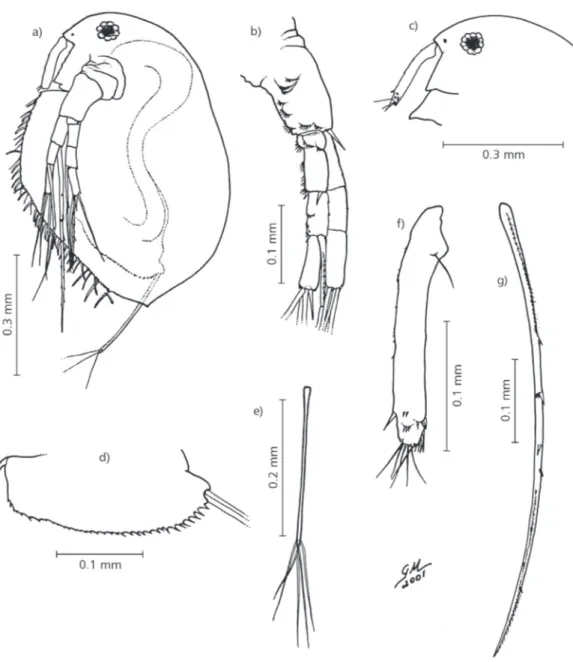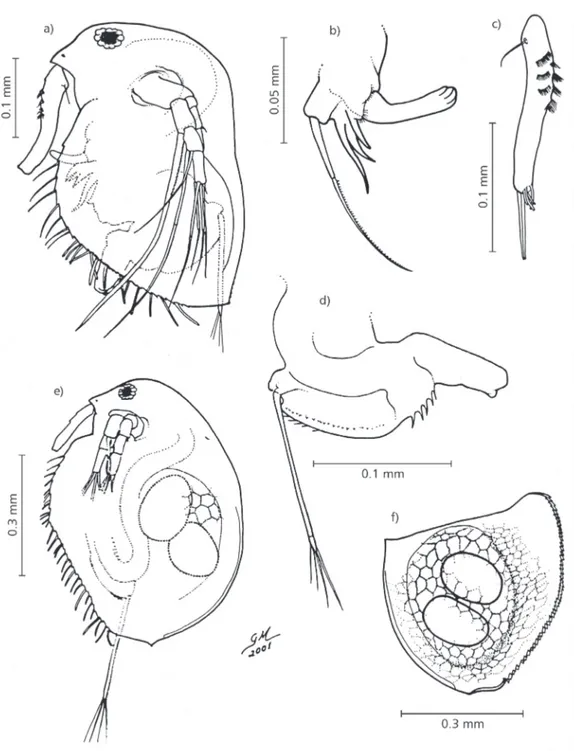Macrothrix flabelligera
, A NEWLY-RECORDED CLADOCERA
MACROTHRICIDAE IN BRAZILIAN FRESHWATERS
GÜNTZEL, A. M.,1 MATSUMURA-TUNDISI, T.1 and ROCHA, O.2
1Instituto Internacional de Ecologia, Rua Bento Carlos, 750, CEP 13560-660, São Carlos, SP, Brazil 2Universidade Federal de São Carlos, Departamento de Ecologia, C.P. 676, CEP 13565-905, São Carlos, SP, Brazil
Correspondence to: Adriana Maria Güntzel, Instituto Internacional de Ecologia, Rua Bento Carlos, 750, CEP 13560-660, São Carlos, SP, Brazil, e-mail: aguntzel@uol.com.br
Received October 7, 2002 Accepted Dezember 16, 2002 Distributed May 31, 2004
(With 2 figures)
ABSTRACT
A short characterization of Macrothrix flabelligera Smirnov, 1992 (Cladocera, Macrothricidae) is pre-sented, following a recent record of this species in Brazil. General aspects and morphological details of the body of parthenogenetic and ephippial females, as well as of males, are described and illustrated. Key words: Cladocera, Macrothricidae, Macrothrix flabelligera, zooplankton.
RESUMO
Macrothrix flabelligera, um Cladocera Macrothricidae
recentemente registrado em águas doces brasileiras
Este artigo apresenta breve caracterização de Macrothrix flabelligera Smirnov, 1992 (Cladocera, Macrothricidae), após o recente registro dessa espécie no Brasil. Os aspectos gerais e os detalhes morfológicos do corpo das fêmeas partenogenéticas e efipiais, bem como dos machos, são descritos e ilustrados.
Palavras-chave: Cladocera, Macrothricidae, Macrothrix flabelligera, zooplâncton.
INTRODUCTION
Recent studies have shown a great deficiency in the taxonomical knowledge of Cladocera, considering that only a small percentage of the known species are well described or can be con-sidered valid species by taxonomical criteria applied to their identification (Korovchinsky, 1996).
Among Cladocera, the Macrothricidae is one of the least-studied families and, as a consequence, many species have recently been redescribed (Kotov, 1999; Silva-Briano et al., 1999). The species Macrothrix flabelligera was first described by Smirnov (1992) from specimens collected in Lake Powlathanga, Queensland, Australia. The closest species is M. triserialis, from which M. flabelligera differs in possessing a modification in the structure of the antenna (Smirnov, 1992).
Very little is known about the distribution of
According to Smirnov (1992), it is possible that the material collected in Cuba and Iraq by Korinek (1984) could also be M. flabelligera.
The first record of this species in Brazil was at a small oxbow lake, Lake Cristal, at Jataí Ecological Reserve, Luís Antônio District, São Paulo State (21°33S; 47°51W) (Santos-Wisniewski et al., 2000) and this species has so far been recorded in several water bodies in the Mogi-Guaçu, Tietê, and Jacaré River basins (Güntzel et al., 1992).
A biodiversity study being performed as part of the wide-ranging Biota project being promoted by Fapesp (São Paulo State Research Foundation) has allowed a comprehensive inventory of Cladocera in São Paulo State, thus expanding existing knowledge on the geographical distribution of Macrothrix flabelligera (Güntzel et al., 1992).
222 GÜNTZEL, A. M., MATSUMURA-TUNDISI, T. and ROCHA, O.
from Marisa Reservoir, municipality of Araraquara, SP, which provided abundant ephippial females and males necessary for a detailed description of the species.
When the morphology of males and parthe-nogenetic and ephippial females of M. flabelligera are compared with descriptions and illustrations of Macrothrix elegans, a species described by Sars (1901) from material also collected in São Paulo State, the two species are observed to be similar in all but the antennae, which were not described by that author. This suggests that the species could be synonymous. It must be pointed out, however, that M. elegans was considered by Smirnov (1992) a synonym of M. triserialis. This problem is insoluble since the Sars (1991) material is not available and the antennae morphology, a detail necessary to distinguish M. flabelligera from M. triserialis, is absent from Sars description.
Dumont et al. (2002), in reviewing the group Macrothrix rosea-triserialis, considered M. elegans a synonym of M. superaculeata. Considering that the species described in the present work differs from the latter by the presence of pectens of decreasing size in the first, second, and third exopod segments, the possibility of the present species being M. superaculeata can be excluded.
The aim of the present study is to provide a detailed description of Macrothrix flabelligera, and to make comparisons with the closest species described by Sars (1901) and Smirnov (1992).
MATERIAL AND METHODS
Sampling was carried out in the littoral zone of Marisa Reservoir, located in the municipality of Araraquara, State of São Paulo (21°55.31S-48°06.35W), close to large stands of the macrophyte Eichhornia crassipes. Live organisms were brought to the laboratory and Macrothrix flabelligera individuals were isolated. At the laboratory they were kept in 2 L glass flasks with water, from a pond located on the campus of the Federal University of São Carlos (São Paulo State), previously filtered through 45 µm plankton net. The individuals were fed with an algal suspension of Scenedesmus bijugus,
nogenetic and ephippial females, males, and their exuviae were taken from the cultures and preserved in 4% formalin solution. Individuals were dissected under a stereomicroscope and permanent slides were mounted with whole individuals and taxonomically important body parts. A camera lucida was used for drawings. Measurements were obtained from a reticulated microscale coupled to a microscope eye piece.
RESULTS
Morphology of Macrothrix flabelligera
Smirnov, 1992
Parthenogenetic female (Fig. 1)
224 GÜNTZEL, A. M., MATSUMURA-TUNDISI, T. and ROCHA, O.
Ephippial female and ephippium
General aspect of the body similar to that of parthenogenetic female (as shown in Fig. 2), except for shell sculpture that is reticulate in the middle portion (ephippium region). Two ephippial eggs larger than the parthenogenetic ones (180-200 µm). Ephippium triangular. Body size range for ephippial female: 620-730 µm.
Male
Male much smaller than female; antennules more developed, with one strong bristle at the base anteriorly and 4 rows of rigid hairs in its proximal portion; claw of the first pair of legs formed by 3 superposed lamellae at the tip. Distal portion of post-abdomen forming a cyllindrical tube, transversely truncated at the tip, and with ejaculatory duct near dorsal end. Mean body size: 367.5 µm. Fig. 2 shows the main taxonomical characteristics of the M. flabelligera male.
DISCUSSION
Among the 7 genera of Macrothricidae known to occur in South America (Paggi, 1976), only three are recorded in Brazil: Macrothrix, Streblocerus, and Grimaldina. The latest inventory of Macrothricidae in São Paulo State showed the occurrence of seven species, 6 belonging to the genus Macrothrix, and one to Streblocerus (Rocha & Güntzel, 1999).
The distribution of M. flabelligera, M. triserialis, and M. superaculeata in Brazil needs to be carefully reviewed, considering the great morphological similarity among the three species. According to Smirnov (1992), the species M. flabelligera can be distinguished from M. triserialis because it has pectens of additional spines in the first, second, and third segments of the 4-segmented branch of the antennal exopod.
M. flabelligera also differs from M. superaculeata, another closely related species, in which the additional spines present in the second and third segments are simple. Pectens of spines, as found in M. flabelligera, are absent from this species antennae.
A comparison of M. flabelligera described by Smirnov (1992) and M. elegans, the species
of pectens in the exopod, observed for M. flabelligera, was not recorded by Sars in M. elegans. These are probably the same species, but the name M. flabelligera was adopted in the present work because Smirnovs description is more complete. Cladocera males are rarely observed in na-tural populations, although they are essential for taxonomic identification at the species level. In the genus Macrothrix, which includes 34 species, males are known in only 12 species (Smirnov, 1992). Sexual dimorphism in cladocerans is observed, including differences in shape and size that might be species-specific. The main morphological distinction between males and females are in the antennule, post-abdomen, and in the hook on limb I. The aperture of the vas deferens is also an important character in identified the Macrothrix species.
Kotov (1999) emphasizes that the presence, length, and armature of antennule setae in the male are important characters, but rarely used in the taxonomy of Macrothrix. Regarding M. flabelligera, Korinek (1984) presents a short description of the male characteristics, which were also fully observed and described in the present study. Probably, there is a great similarity among the males because the three species M. triserialis, M. superaculeata, and M. flabelligera are closely related. The real distinction, if it exists, could only be made if the males of all three species were found and completely described using electronic microscopy. The importance of culturing in the laboratory species that are not well known, which is true of most species of Macrothricidae, was evidenced by the results obtained in the present study. The ease of observing morphological characteristics in the exuviae, as well as that of obtaining a sufficient number of males and ephippial females from the cultures, makes laboratory culturing an important tool in taxonomical studies.
226 GÜNTZEL, A. M., MATSUMURA-TUNDISI, T. and ROCHA, O.
Acknowledgments The authors wish to thank the International Institute of Ecology and the Federal University of São Carlos for providing infrastructure. The present work is part of the subproject Zooplankton diversity related to conservation and degradation of freshwater ecosystems of São Paulo State, included in the program Biota/Fapesp The Virtual Institute of Biodiversity (www.biotasp.org.br).
REFERENCES
DUMONT, H. J., SILVA-BRIANO, M. & BABU, S., 2002, A re-evaluation of the Macrothrix rosea-triserialis group, with the description of two new species (Crustacea Anomopoda: Macrothricidae). Hydrobiologia, 467: 1-44.
GÜNTZEL, A. M., ROCHA, O., SANTOS-WISNIEWSKI, M. J. & MATSUMURA-TUNDISI, T., 1992, Diversity of littoral Cladocera (Macrothricidae and Ilyocryptidae) from Brazilian lakes and reservoirs, with some remarks on the life cycle of Macrothrix flabelligera, Smirnov. Verh. Internat. Verein. Limnol., 28 (in press).
KOROVCHINSKY, N. M., 1996, How many species of Cladocera are there? Hydrobiologia, 321: 191-204. KOTOV, A. A., 1999, Redescription of Macrothrix tripectinata
Weisig, 1934 (Anomopoda, Branchiopoda), with a discussion of some features rarely used in the systematics of the genus.
Hydrobiologia,403: 63-80.
KORINEK, V., 1984, Cladocera. Hydrobiological survey of the Lake Bangwelulu Luapula River basin. Scientific results,13(2): 1-117.
PAGGI, J. C., 1976, Cladoceros Macrothricidae nuevos para la fauna Argentina. Physis., Sección B, 35: 103-112. ROCHA, O. & A. GÜNTZEL, 1999, Branchiopoda, Cladocera.
In: D. Ismael, W. C. Valenti, T. Matsumura-Tundisi, T. & O. Rocha (eds.), Biodiversidade do Estado de São Paulo, Brasil: síntese do conhecimento ao final do século XX, 4: Invertebrados de água doce. São Paulo, Fapesp, 176p.
SANTOS-WISNIEWSKI, M. J., ROCHA, O., ESPÍNDOLA, E. L. G. & RIETZLER, E. C., 2000, Diversidade do zooplâncton das lagoas marginais do rio Mogi-Guaçu. II. Cladocera (Crustacea, Branchiopoda). In: J. E. Santos & J. S. R. Pires (eds.), Estudos integrados em ecossistemas. Estação Ecológica de Jataí, vol. 2. São Carlos, RiMa, pp. 559-586. SARS, G. O., 1901, Contribution to the knowledge of the
freshwater Entomostraca of South America. Part. I. Cladocera. Archiv for Matematik og Naturvidenskab, Christiania,22(6): 3-27.
SILVA-BRIANO, M., DIEU, N. Q. & DUMONT, H. J., 1999, Redescription of Macrothrix laticornis (Jurine, 1820) and description of two new species of the M. laticornis-group.
Hydrobiologia,403: 39-61.

